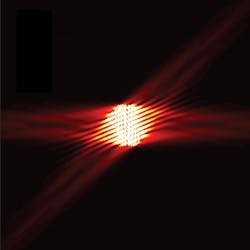New polarimeter from Capasso's lab at Harvard can be integrated on a chip
Researchers at the Harvard University John A. Paulson School of Engineering and Applied Sciences (SEAS; Cambridge, MA) and Innovation Center Iceland (Reykjavík, Iceland) have built a polarimeter on a microchip, revolutionizing the design of this widely used scientific tool.1
"We have taken an instrument that is can reach the size of a lab bench and shrunk it down to the size of a chip," says Federico Capasso, the Robert L. Wallace Professor of Applied Physics and Vinton Hayes Senior Research Fellow in Electrical Engineering, who led the research. "Having a microchip polarimeter will make polarization measurements available for the first time to a much broader range of applications, including in energy-efficient, portable devices."
Harvard's Office of Technology Development has filed a patent application and is actively exploring commercial opportunities for the technology.
Capasso's team fabricated a two-dimensional metasurface covered with a thin array of metallic subwavelength antennas embedded in a polymer film. When light fed to the device via optical fiber illuminates the array, a small amount scatters in four directions. Four detectors measure the intensity of the scattered light and the information is combined to give the state of polarization in real time.
"One advantage of this technique is that the polarization measurement leaves the signal mostly intact," says J. P. Balthasar Mueller, a graduate student in the Capasso lab. "This is crucial for many uses of polarimeters, especially in optical telecommunications, where measurements must be made without disturbing the data stream."
"The design of the antenna array makes it robust and insensitive to the inaccuracies in the fabrication process, which is ideal for large scale manufacturing," says Kristjan Leosson, senior researcher and division manager at the Innovation Center and coauthor of the paper.
Leosson's team in Iceland is currently working on incorporating the metasurface design from the Capasso group into a prototype polarimeter instrument.
The research was funded by the Air Force Office of Scientific Research and the Icelandic Research Fund.
Source: http://www.eurekalert.org/pub_releases/2016-01/hjap-nmr010716.php
1. J. P. Balthasar Mueller et al., Optica (2016); doi: 10.1364/OPTICA.3.000042

John Wallace | Senior Technical Editor (1998-2022)
John Wallace was with Laser Focus World for nearly 25 years, retiring in late June 2022. He obtained a bachelor's degree in mechanical engineering and physics at Rutgers University and a master's in optical engineering at the University of Rochester. Before becoming an editor, John worked as an engineer at RCA, Exxon, Eastman Kodak, and GCA Corporation.
